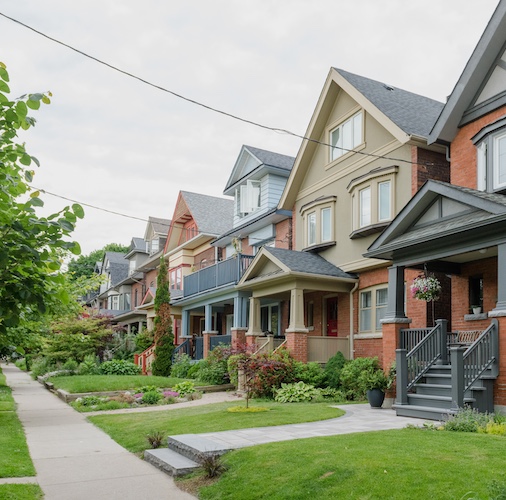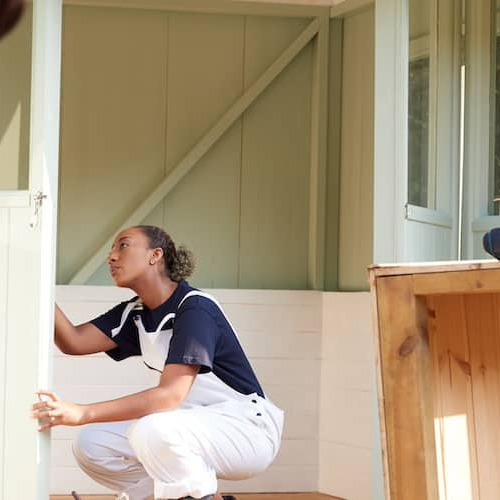USDA vs. conventional loans: What's the difference?
Contributed by Karen Idelson, Tom McLean
Apr 25, 2025
•6-minute read
Effective November 16, 2025, both Fannie Mae and Freddie Mac are removing the minimum credit score requirement from their conventional loan eligibility guidelines. Loan approval will instead be based on an evaluation of overall credit risk factors.
While conventional loans are the most common mortgage option, if you live in a rural area, you may be considering a USDA loan. Rocket Mortgage® doesn’t currently offer USDA loans, but we can help you evaluate your options when it comes to home lending.
We've created a comprehensive guide that compares USDA and conventional loans to help you determine which is right for you.
Requirements for USDA and conventional loans
USDA loans are subsidized by the U.S. government, and more specifically, are backed by the U.S. Department of Agriculture. In other words, the USDA takes on the responsibility of paying the lender back if you default on your mortgage.
Since the USDA is taking on a lot of the risk, your lender can offer you a lower interest rate. Ultimately, government-backed loans make it affordable for lower-income households to buy a home.
Unlike USDA loans, conventional mortgages aren’t insured by the U.S. government. Conventional loans fall into two categories: conforming and non-conforming. Conforming loans are purchased by two government-sponsored enterprises, Fannie Mae and Freddie Mac – so they have to fit Fannie Mae’s and Freddie Mac’s guidelines. Non-conforming loans, on the other hand, are less standardized in terms of eligibility, pricing and features.
USDA loan eligibility
To qualify for a USDA loan, the home must be in an eligible rural area and you must meet specific income requirements. Keep in mind that USDA construction loan requirements differ from USDA loans. Let’s look at those requirements, as well as the credit score, debt-to-income ratio and down payment requirements.
Rural area requirements
To get a USDA loan, the home you’re buying or refinancing must be located in an eligible rural area; you can check the eligibility of the address on the USDA website. If you look at the property eligibility map, you’ll notice that the USDA’s definition of “rural area” is very broad. Many homes in suburban areas qualify as “rural” based on the USDA’s definition.
Income requirements
USDA loans are one of the only types of mortgages that specify income limits. These income limits depend on the location of the home you’d like to buy and the number of people in your household.Under the guidelines, you’re ineligible for a USDA loan if your household income exceeds 115% of the median income for your area. This requirement includes all adults that live in the house – not just the adults listed on the mortgage.
Credit score
To be eligible for a USDA loan, you must have a credit score of at least 640 for automated approval. With a credit score of 600 – 640, you will have to go through manual underwriting where an underwriter will comb through your records.
Debt-to-income ratio
When lenders assess your ability to pay back your loan, they also look at your debt-to-income ratio (DTI). Your DTI represents the amount of your monthly income that goes toward paying off recurring debt. It’s best to keep your DTI at 50% or below if you want to qualify for a USDA loan.
Down payment requirements
USDA loans don’t require a down payment. Because the government backs USDA loans, lenders can issue them with no money down. This can be a huge advantage if you lack the money for a down payment. However, keep in mind that you’ll still need to pay closing costs.
Conventional loan eligibility
Conventional loans are more widely available because they don’t have any location limitations. Let’s look at the requirements you’ll need to meet to qualify for a conventional loan.
Credit score
The credit score requirements for conventional loans vary by lender and by the exact type of conventional loan you’re getting. In general, you’ll need a credit score of 620 for a conventional loan, but a higher credit score could mean even better interest rates and terms.
Debt-to-income ratio
The debt-to-income ratio (DTI) requirements vary based on the specifics of the loan. In general, shoot for a DTI of 50% or lower.
Down payment and mortgage insurance
You can qualify for a conventional loan with a down payment as low as 3%. However, it’s important to know that if your down payment is under 20%, you’ll be required to pay for private mortgage insurance (PMI). PMI will add money to your monthly mortgage payment, but it allows you to get into a home sooner because you won’t have to save 20% for a down payment.
PMI won’t be on your loan forever; it will be canceled when you have enough equity in your home. You can ask your lender to remove PMI once you’ve paid 20% of the purchase price.
Loan limits
Fannie Mae and Freddie Mac set loan amount limits for conventional loans. The conventional loan limit for 2025 is $806,500. In some high-cost areas of the country, the loan limit is higher – up to $1,209,750, depending on the county.
|
USDA vs. conventional loan eligibility requirements |
||
|
|
USDA loan |
Conventional loan |
|
Location |
Rural areas only |
n/a |
|
Income |
Household income < 115% of area median income |
n/a |
|
Credit score |
n/a |
620 |
|
Debt-to-income ratio |
41% or below |
50% or below |
|
Down payment |
n/a |
3% |
Comparing USDA vs. conventional loans
There are some key differences between USDA and conventional loans. Let’s look at the major differences so you can decide which loan type is right for you.
Location
Conventional loans are available nationwide. USDA loans, on the other hand, are only available in eligible rural areas as determined by the USDA. If you’re located in a major metropolitan area, you likely won’t be able to get a USDA loan. Just keep in mind that the USDA’s definition of rural areas includes many suburbs as well.
Residence type
USDA funding can only be used on your primary residence, but conventional loans don’t have these same restrictions. You can get a conventional loan for a number of reasons, including buying or refinancing your primary residence, secondary residence or investment property.
Income limits
There are limits on how much you can make in order to qualify for a USDA loan. Your household income can’t exceed 115% of the area’s median income. All members of the household will need to have their income considered by the lender.
If you’re trying to qualify for a conventional loan, on the other hand, there are no income limits.
Private mortgage insurance and guarantee fees
Conventional loans require private mortgage insurance (PMI) from borrowers who put less than 20% down. This fee is based on your loan-to-value ratio (LTV) and your credit score. It generally ranges from about .1% – 2% of the unpaid loan amount. Borrowers with lower credit scores and higher LTVs (i.e., lower down payments) generally have to pay more for PMI.
USDA loans, on the other hand, require you to pay a guarantee, or funding, fee. This fee is paid both at closing and monthly. The upfront fee, paid at closing, is 1% of the loan amount. Then, each year, you’ll pay .35% of the scheduled unpaid principal balance of the mortgage. This annual fee is split over 12 months and paid as part of your monthly payment.
Whether private mortgage insurance or the USDA guarantee fee is cheaper for you all depends on your personal situation. If you have a lower credit score or down payment, the guarantee fee may be cheaper than the cost of PMI.
Appraisals
An appraisal is an unbiased estimate of the fair market value of a home. The appraisal is a vital step to ensure that you don’t overpay for your home. Both USDA and conventional mortgages require an appraisal.
During the appraisal inspection, the appraiser will look for any major problems with the home. Properties financed with a USDA loan (or other government-backed loan) will generally have to meet stricter requirements than properties financed with a conventional loan. If you’re buying a fixer-upper, a conventional loan may be a better bet.
Available interest rates
Outside of the down payment, one of the biggest appeals of a USDA loan is that it's offered at a low interest rate. In many cases, interest rates for USDA loans are lower than rates for conventional loans. The government backing of USDA loans typically means that lenders can issue them with competitive interest rates.
Approval process
Getting an approval for a USDA loan might take slightly longer than getting an approval for a conventional loan. Since the USDA loan needs to be approved by both the lender and the USDA, the entire process, from application to closing, can take approximately 30 – 60 days.
The bottom line
Before you decide which loan is best for you, consider your current situation and where you want to live.
If you can’t put money down, are in a low-to-moderate income range and want to purchase your home in a rural area, a USDA loan might be your best fit.
However, if you have money to put down and don’t want to be limited on where you can buy, a conventional loan might make the most sense for you.
Apply online with Rocket Mortgage® if you’re ready to start your mortgage application. You’ll be able to compare different mortgage solutions to find the right choice for you.

Josephine Nesbit
Josephine Nesbit is a full-time freelance writer specializing in real estate, mortgages, and personal finance. Her work has been featured in U.S. News & World Report, GoBankingRates, Homes.com, Fox Business, USA Today Homefront, and other publications where she helps readers navigate the housing market and manage personal finances.
Related resources

4-minute read
Choosing a bridge loan vs. a HELOC: What's right for you?
Bridge loans and HELOCs can cover you financially if you need to buy and sell a house at the same time. Learn more about which is best for you.
Read more

8-minute read
Different types of mortgages and how they work
There is a home loan for everyone, but which type of mortgage is best for you? Use this article to understand the types of home loans and how they work.
Read more

10-minute read
8 HELOC alternatives to know
A HELOC can help you get the money you need, but it may not be the best option for everyone. Explore these HELOC alternatives and decide what’s right for ...
Read more